


Manganese(II) at very high concentration
In this experiment it is investigated how manganese(II) ions behave at very high concentration in hydrochloric acid. Some websites mention the formation of a yellow complex in concentrated hydrochloric acid, but this could not be confirmed in this experiment. Even at ultra-high concentration, at the point, where the liquid becomes syruppy, the manganese(II) ion still is faint pink. Yellow and greenish colors can be observed, but these are shown to be due to oxidation of managese(II) in the concentrated solution.
![]()
![]() Required
chemicals:
Required
chemicals:
-
manganese metal of very high purity (electrolytic, 99.99%)
-
manganese chloride, reagent grade
- concentrated hydrochloric acid, reagent grade, 37% HCl by weight
- potassium permanganate, reagent grade
- hydrogen peroxide, 10%
- sodium sulfite
![]() Required
equipment:
Required
equipment:
-
test tubes
- clamp
- heater for test tube
![]() Safety:
Safety:
- concentrated hydrochloric acid is very corrosive and gives off pungent fumes, which must not be inhaled.
![]() Disposal:
Disposal:
- The solutions should be kept aside and be brought to a waste processing facility.
![]()
Procedure for performing the experiment
![]() Take two
spatulas full of manganese(II)chloride 4-hydrate and dissolve this in as little
as possible of reagent grade concentrated hydrochloric acid.
When this is done, then a nearly colorless liquid is
obtained. Careful observation, however, shows that it has a faint yellow/brown
color.
Take two
spatulas full of manganese(II)chloride 4-hydrate and dissolve this in as little
as possible of reagent grade concentrated hydrochloric acid.
When this is done, then a nearly colorless liquid is
obtained. Careful observation, however, shows that it has a faint yellow/brown
color.
It is not that easy to get much of the manganese(II)chloride in solution. This requires some heating and even then only a few hundreds of mg can be dissolved in 2 ml of concentrated hydrochloric acid. The pale yellow color suggests formation of a manganese/chloride complex with yellow color, but it also could be due to oxidation of a tiny part of the manganese(II) ions to a higher oxidation state. This latter hypothesis is tested with three additional experiments:
- Addition of a small amount of an oxidizer to the concentrated solution of manganese(II)chloride, and looking at the color of the solution.
- Addition of a very small amount of potassium permanganate to concentrated hydrochloric acid. This produces manganese in lower than +7 oxidation states and the color is checked.
- Preparation of a solution, containing manganese(II) in even higher concentration, by dissolving very pure manganese metal in concentrated hydrochloric acid.
- Final experiment is addition of a reductor to the brown/yellow solution, obtained after performing experiment 1.
![]() Experiment 1: Addition of oxidizer to concentrated solution of MnCl2
Experiment 1: Addition of oxidizer to concentrated solution of MnCl2
Add two drops of 10% hydrogen peroxide to the faintly yellow solution of manganese(II)chloride in hydrochloric acid. When this is done, then the solution at first does not seem to change, but quickly it becomes green/yellow and bubbles of chlorine gas are produced. The air above the liquid turns pale green, due to the presence of chlorine gas. On gentle heating and shaking the test tube, the chlorine disappears again, and the liquid becomes darker brown/green as shown in the picture below.
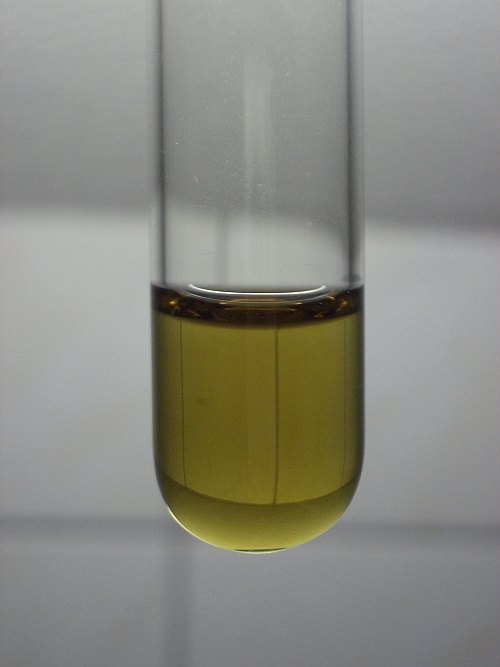
The picture clearly shows that the few drops of hydrogen peroxide have a strong effect on the color of the solution. This needs some patience and heating though. The brown/green color is due to formation of a compound of manganese at higher than +2 oxidation state.
![]() Experiment 2: Addition of KMnO4 to concentrated HCl
Experiment 2: Addition of KMnO4 to concentrated HCl
In this experiment, a tiny amount (just a few small crystals of 0.2 mm diameter) of solid potassium permanganate is added to concentrated hydrochloric acid. When this is done, the permanganate oxidizes the hydrochloric acid, itself being reduced to a compound of lower than +7 oxidation state. It is not reduced to oxidation state +2, some higher oxidation state is obtained. A dark green/brown substance is formed, which is green/yellow at high dilution. The left picture nicely shows the dilute solution with brown material coming from the crystals of potassium permanganate. The right picture shows the liquid after all potassium permanganate has dissolved.
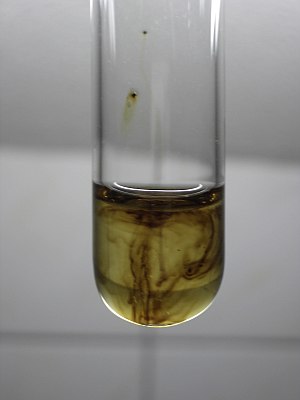
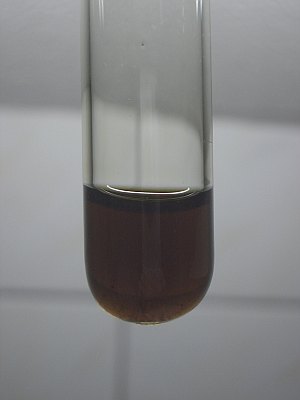
The color of the highly dilute solution strongly resembles the color of the solution of manganese(II)chloride to which some hydrogen peroxide is added. Again, the green/brown compound is formed, but now from the other direction from a higher oxidation state.
When the dark brown liquid, as shown in the right picture above, is boiled for a while, then the color becomes lighter, due to further reduction of the manganese to oxidation state +2. The color again is yellow/brown with a green tinge.
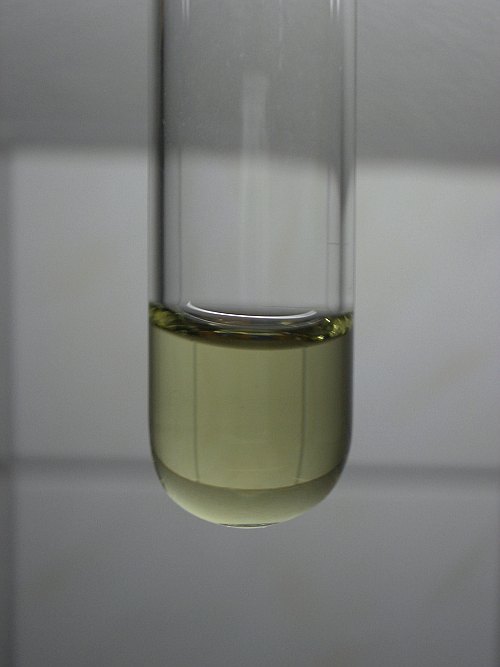
![]() Experiment 3: Solution of MnCl2 at very high concentration
Experiment 3: Solution of MnCl2 at very high concentration
In this experiment it is shown that a really high concentration of manganese(II)chloride in concentrated hydrochloric acid does not lead to a yellow solution but to a pink solution, in which the pink color can be seen clearly. For this purpose, a piece of manganese metal is dissolved in some concentrated hydrochloric acid in a loosely stoppered test tube. A very pure piece (99.99%) of metal is used: electrolytically prepared manganese metal, which does not contain any iron. When this is dissolved, first a somewhat greenish solution is obtained, but the manganese metal and nascent hydrogen, formed in this reaction make the environment strongly reducing and as long as there is metallic manganese, the liquid remains nicely pink.
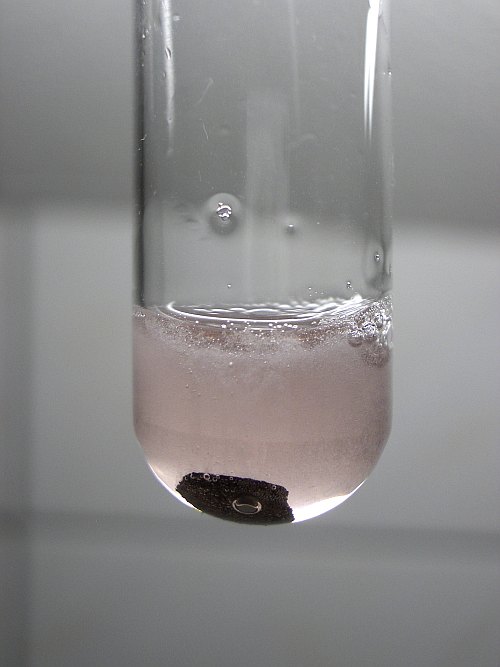
The picture shows the remains of a piece of metallic manganese, very fine bubbles of hydrogen and a pink solution above the metal. When the metal is added to the hydrochloric acid, then at first a violent reaction occurs, and the liquid becomes very hot. Cooling with some running water from a tap may be necessary in order to keep the reaction controlled. After a while, the reaction slows down, even when the liquid is still strongly acidic. The liquid becomes viscous, the concentration of manganese(II)chloride becomes very high. The liquid does not solidify though. Here, even at the high concentration of manganese(II) ions and chloride ions, no yellow color is observed, but a nice pink color, the color of manganese(II) at very high concentration. The pure pink color only remains as long as there is a piece of metal in the liquid. When all manganese is used up, then the color shifts towards brown and a mix of a yellow/brown color and the pink color is obtained, due to aerial oxidation.
![]() Experiment 4: Treat liquid of experiment 1 with some Na2SO3
Experiment 4: Treat liquid of experiment 1 with some Na2SO3
The brown/yellow liquid, obtained after performing experiment 1 contains mostly manganese(II) but also some manganese in a higher oxidation state. To this liquid a small amount of solid sodium sulfite is added. This causes immediate and complete reduction of the manganese to oxidation state +2. The brown/yellow liquid then almost immediately turns into a nearly colorless solution, as shown in the picture below.
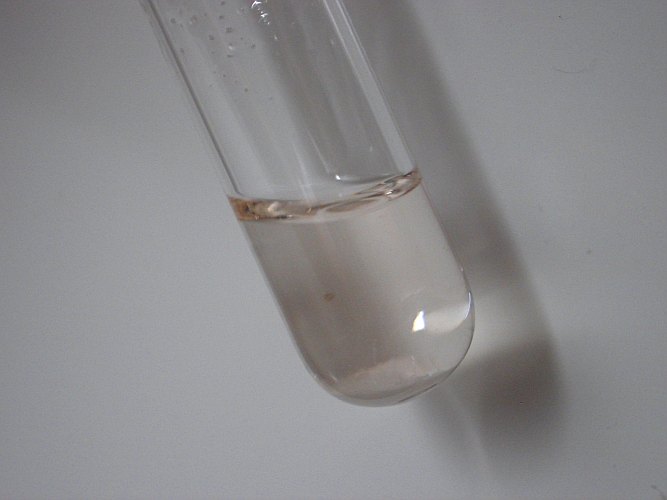
The liquid has a very pale pink color, almost invisible. Only at the meniscus of the liquid one can clearly see that it is pink. At the bottom, still some white solid remains, which most likely is solid NaCl, formed in the concentrated hydrochloric acid, mixed with remains of undissolved Na2SO3.
![]()
Discussion of results
In some textbooks, mention is made of a yellow complex of manganese(II) with chloride ions, which is formed at very high concentration of chloride ion. This would be similar to the situation for copper(II) ions, where without any doubt a chloro-complex is formed at high concentration of chloride ion.
This set of experiments gives strong evidence for the hypothesis that this is not the case for manganese(II) ions and that any yellow color most likely is due to oxidation of a tiny part of the manganese(II) ions to some higher oxidation state. This higher oxidation state compound has a very intense color and even at really low concentration it can be observed already. The experiment with potassium permanganate shows how intense the color is, just a few crystals of a diameter of 0.2 mm make the liquid almost appear black. This observation nicely supports the hypothesis that even a tiny amount of oxidized manganese ions may make the liquid appear yellow instead of colorless of faintly pink.
Experiment 3 with the metallic manganese also is very instructive and this shows best that no yellow complex is formed. The loosely stoppered test tube remains filled with hydrogen gas and the presence of the piece of manganese and the very fine bubbles of hydrogen gas all assure that a reducing enviroment is present and that no manganese is oxidized to a higher oxidation state. Under such conditions the solution is pink, even at really high concentration and no trace of a yellow compound can be observed.
Finally, the reduction of the yellow/brown/green solution obtained at the end of experiment 1 also shows that no yellow complex is formed at high concentration of chloride ion. The completely reduced solution shows the same pink color as in experiment 3, albeit much more faintly, due to the lower concentration of manganese(II) ions.